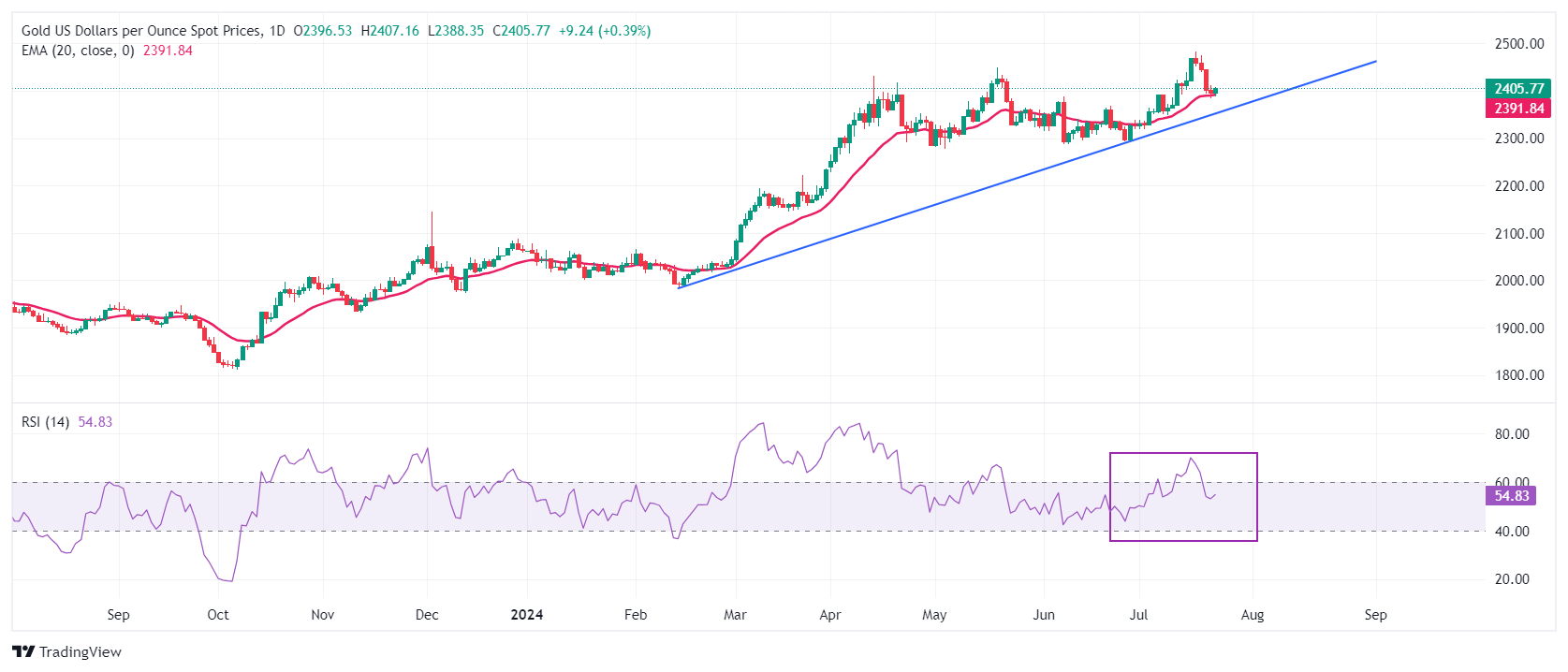- Gold price bounces back in the countdown to a string of US economic data.
- Firm Fed rate cut hopes to keep the upside in the US Dollar limited.
- Gold price in India sinks after customs duty reduction.
Gold price (XAU/USD) gains ground near the round-level resistance of $2,400 in Tuesday’s North American session. The precious metal finds cushion as US bond yields slumps amid firm speculation that the Federal Reserve (Fed) will begin lowering its key borrowing rates from September. 10-year US Treasury yields tumble to near 4.23%. Higher yields on interest-bearing assets reduce the opportunity cost of holding an investment in non-yielding assets, such as Gold.
Earlier, the Gold price was under pressure amid expectations that Donald Trump could emerge victorious in the United States (US) presidential elections in November. The expectations for Donald Trump gaining a second term rose after an assassination attack on him and US President Joe Biden’s withdrawal of his re-election bid from the White House. However, US Vice President Kamala Harris has been chosen as the nominee of Democrats.
Growing speculation for Trump 2.0 has prompted upside risks to consumer inflation expectations. In a note on Monday, Australian investment bank Macquarie said, "Trump 2.0 will be a more inflationary policy regime, given restricted immigration, higher tariffs, and the extension of the Tax Cut and Jobs Act of 2025." The scenario is favorable for the US Dollar (USD). The US Dollar Index (DXY), which tracks the Greenback’s value against six major currencies, jumps to near 104.50.
Daily digest market movers: Gold price on MCX in India nosedives on custom duty reduction
- Gold price rebounds above the crucial resistance of $2,400. However, the near-term outlook of the Gold price is still uncertain as investors await a slew of US economic data, which will be published this week.
- Investors will focus on the preliminary US S&P Global PMI for July, Q2 Gross Domestic Product (GDP), and Durable Goods Orders and Personal Consumption Expenditures Price Index (PCE) data for June, which will provide fresh cues about when the US Federal Reserve (Fed) will start reducing interest rates.
- The Manufacturing PMI is estimated to have expanded at a meager pace to 51.7 from June’s reading of 51.6. The Services PMI, a measure of activities in the service sector, is estimated to have expanded at a slower pace of 54.4 from the prior release of 55.3.
- The major trigger will be the Fed’s preferred inflation gauge, the PCE index, which will indicate whether price pressures remain on track to return to the desired rate of 2%. The confidence of Fed officials that inflation has returned to the path of 2% grew after recent inflation readings showed that price pressures rose at a slower-than-expected pace in June.
- According to the CME FedWatch tool, 30-day Federal Fund futures show the central bank beginning to lower its key borrowing rates from their current levels in the September meeting. The Fed is also expected to cut interest rates again in November or December.
- In the Indian region, Multi Commodity Exchange (MCX) Gold price nosedives below Rs. 69,000 after Prime Minister Narendra Modi-led-NDA reduces basic custom duty on precious metals to 6% from 10% in the Fiscal Budget 2024-2025. The decision is expected to boost demand for physical gold.
Technical Analysis: Gold price holds $2,400
Gold price recaptures the crucial figure of $2,400. The precious metal finds cushion near the 20-day Exponential Moving Average (EMA), which trades around $2,390, suggesting that the near-term outlook has not weakened yet technically.
The advancing trendline plotted from the February 14 low at $1,984.30 will be a major support for Gold bulls.
The 14-day Relative Strength Index (RSI) drops inside the 40.00-60.00 range, suggesting that the upside momentum has stalled. However, the upside bias remains intact.
A fresh upside would appear if the Gold price breaks above all-time highs above $2,480.
Interest rates FAQs
Interest rates are charged by financial institutions on loans to borrowers and are paid as interest to savers and depositors. They are influenced by base lending rates, which are set by central banks in response to changes in the economy. Central banks normally have a mandate to ensure price stability, which in most cases means targeting a core inflation rate of around 2%. If inflation falls below target the central bank may cut base lending rates, with a view to stimulating lending and boosting the economy. If inflation rises substantially above 2% it normally results in the central bank raising base lending rates in an attempt to lower inflation.
Higher interest rates generally help strengthen a country’s currency as they make it a more attractive place for global investors to park their money.
Higher interest rates overall weigh on the price of Gold because they increase the opportunity cost of holding Gold instead of investing in an interest-bearing asset or placing cash in the bank. If interest rates are high that usually pushes up the price of the US Dollar (USD), and since Gold is priced in Dollars, this has the effect of lowering the price of Gold.
The Fed funds rate is the overnight rate at which US banks lend to each other. It is the oft-quoted headline rate set by the Federal Reserve at its FOMC meetings. It is set as a range, for example 4.75%-5.00%, though the upper limit (in that case 5.00%) is the quoted figure. Market expectations for future Fed funds rate are tracked by the CME FedWatch tool, which shapes how many financial markets behave in anticipation of future Federal Reserve monetary policy decisions.
Information on these pages contains forward-looking statements that involve risks and uncertainties. Markets and instruments profiled on this page are for informational purposes only and should not in any way come across as a recommendation to buy or sell in these assets. You should do your own thorough research before making any investment decisions. FXStreet does not in any way guarantee that this information is free from mistakes, errors, or material misstatements. It also does not guarantee that this information is of a timely nature. Investing in Open Markets involves a great deal of risk, including the loss of all or a portion of your investment, as well as emotional distress. All risks, losses and costs associated with investing, including total loss of principal, are your responsibility. The views and opinions expressed in this article are those of the authors and do not necessarily reflect the official policy or position of FXStreet nor its advertisers. The author will not be held responsible for information that is found at the end of links posted on this page.
If not otherwise explicitly mentioned in the body of the article, at the time of writing, the author has no position in any stock mentioned in this article and no business relationship with any company mentioned. The author has not received compensation for writing this article, other than from FXStreet.
FXStreet and the author do not provide personalized recommendations. The author makes no representations as to the accuracy, completeness, or suitability of this information. FXStreet and the author will not be liable for any errors, omissions or any losses, injuries or damages arising from this information and its display or use. Errors and omissions excepted.
The author and FXStreet are not registered investment advisors and nothing in this article is intended to be investment advice.
Recommended content
Editors’ Picks

AUD/USD regains traction toward 0.6300 as RBA Governor Bullock speaks
AUD/USD is marching back toward 0.6300 in Tuesday's Asian trading, capitalizing on RBA Governor Bullock's less dovish comments. The RBA warranted caution on the inflation outlook while maintaining the key rate at 4.1% earleir in the session.

Gold stands tall as tariff jitters outweigh overbought conditions
Gold price closes in on the $3,150 psychological mark in Asian trading on Tuesday, extending its record rally. Gold buyers eagerly await the US announcement of “reciprocal tariffs” on Wednesday for a fresh directional impetus. In the meantime, tariff updates and top-tier US data will likely keep them entertained.

USD/JPY trades on the backfoot below 150.00 amid trade war fears
USD/JPY edges lower in the Asian session on Tuesday as hawkish BoJ expectations continue to offer some support to the Japanese Yen. Subdued US Dollar price action weighs on the pair. Concerns over Trump's tariffs and its impact on the global economic growth remain a drag on the pair.

Ethereum: Short-term holders spark $400 million in realized losses, staking flows surge
Ethereum bounced off the $1,800 support on Monday following increased selling pressure from short-term holders and tensions surrounding President Donald Trump's reciprocal tariff kick-off on April 2.

US: Trump's 'Liberation day' – What to expect?
Trump has so far enacted tariff changes that have lifted the trade-weighted average tariff rate on all US imports by around 5.5-6.0%-points. While re-rerouting of trade will decrease the effectiveness of tariffs over time, the current level is already close to the highest since the second world war.

The Best brokers to trade EUR/USD
SPONSORED Discover the top brokers for trading EUR/USD in 2025. Our list features brokers with competitive spreads, fast execution, and powerful platforms. Whether you're a beginner or an expert, find the right partner to navigate the dynamic Forex market.


